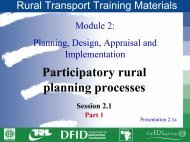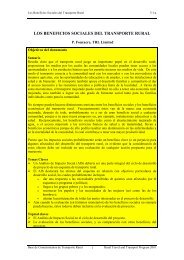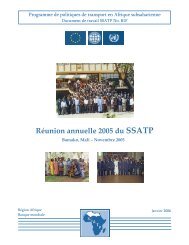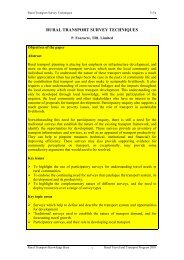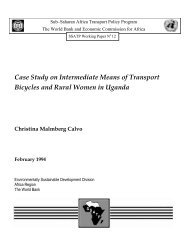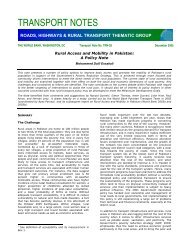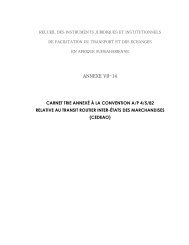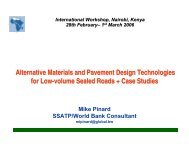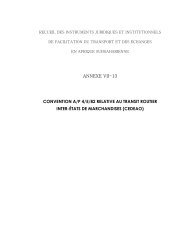Measuring Capacities: An Illustrative Catalogue to ... - World Bank
Measuring Capacities: An Illustrative Catalogue to ... - World Bank
Measuring Capacities: An Illustrative Catalogue to ... - World Bank
Create successful ePaper yourself
Turn your PDF publications into a flip-book with our unique Google optimized e-Paper software.
RESOURCE CATALOGUE<strong>Measuring</strong> <strong>Capacities</strong>:<strong>An</strong> <strong>Illustrative</strong> <strong>Catalogue</strong> <strong>to</strong>Benchmarks and Indica<strong>to</strong>rsCapacity Development GroupBureau for Development PolicySeptember 2005
TABLE OF CONTENTSIntroduction: Measurement of results in capacity development…..3Part 1: Institutional Capacity Indica<strong>to</strong>rs…………………….…….7Part 2: Enabling Environment Capacity Indica<strong>to</strong>rs………...……14Part 3: Thematic Capacity Indica<strong>to</strong>rs………………………….....23This Resource <strong>Catalogue</strong> on Capacity Indica<strong>to</strong>rs is a compilation of indica<strong>to</strong>rs forassessing capability and effectiveness of organizations and the standards of theenvironment in which they must operate. Examples of thematic indica<strong>to</strong>rs (environmentand HIV/AIDS) are also included. This list is not exhaustive. Inclusion of an indica<strong>to</strong>r orassessment framework in this compilation does not imply endorsement by UNDP.Capacity Development GroupBureau for Development PolicyNew YorkSeptember 20052
Introduction: Measurement of Results in Capacity DevelopmentWhat is Capacity Development?In the field of development, the concept of capacity development emerged in the 1980s andbecame the central purpose of technical assistance in the 1990s. It is most commonlydefined as the process by which individuals, groups, institutions and organizations improvetheir ability <strong>to</strong> perform functions, identify and solve problems efficiently and <strong>to</strong> understandand deal with their development need in a broader context and in a sustainable manner.What is a Capacity Assessment?It stands <strong>to</strong> reason that <strong>to</strong> improve, one must first measure existing ability and know-how.Such an evaluation is of particular importance if financial, political or other reasonscontribute a strong rationale for utilizing and strengthening existing capabilities rather thanstarting from scratch.A capacity assessment is an exercise undertaken <strong>to</strong> appraise the existing capacity of anindividual or collective entity <strong>to</strong> perform key functions and deliver expected results. Thus,a capacity assessment links latent capacity with performance. A capacity assessment is anintegral and indispensable part of any capacity development process. It may be conductedby an external assessor or be internalized as standard management practice. It can be anad-hoc event or can (and should) be part of ongoing management and programmingprocesses.Depending on the context of the problem and the resources available, a capacity assessmentcan be conducted at one or more levels-organization, sec<strong>to</strong>r, or individual. But regardlessof the entry point, a capacity assessment must take account of the interconnectedness ofcapacity issues between the targeted level(s) and the enabling environment.Why should we measure capacity?Capacity measures are useful in several ways. They serve <strong>to</strong>:• Support policy dialogue and strategy formulation: as a part of analytical work thatprecedes development investments.• Contribute <strong>to</strong> the detailed design of capacity intervention strategies: by beingintegrated in<strong>to</strong> diagnostic work used <strong>to</strong> design development programmes andprojects.• Enhance moni<strong>to</strong>ring and evaluation: by tracking process and progress with iteratedassessments over time, thus improving capacity development programme designand effectiveness.• Promote institutional learning and empowerment: as an internal learning exercise.3
• Advocate for reform and transformation: by creating interest and desire for changefor the better.There has been considerable recent interest in the UN and wider international developmentcommunity in the broad theme of capacity and measurement <strong>to</strong>ols and indica<strong>to</strong>rs <strong>to</strong> trackdevelopment efforts and effectiveness- existing and developing capacities, progress, andresults of development strategies and interventions.The United Nation’s 2004 Triennial Comprehensive Policy Review focuses on suchquestions as development relevance, comparative advantage and value added of the UNsystem at the country level. A background paper 1 complements the TCPR with specificinformation on the progress made and challenges met by the UN system regarding efforts <strong>to</strong>promote and support national capacity development in programme countries.In 2002, The Economic and Social Council 2 reaffirmed the need for all organizations of theUnited Nations development system at country level <strong>to</strong> focus on capacity development asone of their primary objectives, within their respective mandates, and urged theseorganizations <strong>to</strong>:(a) support governments and other relevant stakeholders in devising country level strategiesfor capacity-building in the pursuit of internationally agreed development goals;(b) intensify inter-agency information sharing on good practices and experience gained,results achieved, benchmarks and indica<strong>to</strong>rs, moni<strong>to</strong>ring and evaluation criteria concerningcapacity-building, and reflect them in the common country assessment and the UnitedNations Development Assistance Framework, and(c) invite all organizations <strong>to</strong> include reporting on capacity-building in their annual reports<strong>to</strong> their respective governing bodies.On March 2, 2005, the participants at the Paris High-Level Forum hosted by the Frenchgovernment issued the "Paris Declaration on Aid Effectiveness," in which they committedtheir institutions and countries <strong>to</strong> continuing and increasing efforts in harmonization,alignment, and managing for results, and for the first time, listed a specific set of actionsand indica<strong>to</strong>rs <strong>to</strong> accelerate progress in these areas - two of which are aimed at measuringprogress on capacity development commitments (Table 1). These indica<strong>to</strong>rs of progressprovide a benchmark against which individual donor agencies or partner countries canmeasure their performance at the country, regional, or global level.1 Effectiveness of the UN development system and its operational activities:capacity of the system <strong>to</strong> provide country level support and develop national capacities2 ECOSOC resolution 2003/03, paragraph 114
Table 1: Capacity Development Indica<strong>to</strong>rs identified in the Paris DeclarationIndica<strong>to</strong>rStrengthen capacity by coordinatedsupportDefinitionPercent of donor support providedthrough coordinated programmesconsistent with partners’ nationaldevelopment strategiesNumber of parallel projectimplementation units per countryStrengthen capacity by avoiding parallelstructuresSource: Organization for Economic Co-operation and Development (2005).How should we measure capacity?The design of measurement <strong>to</strong>ols and indica<strong>to</strong>rs begs adherence <strong>to</strong> certain generalprinciples.• Clarity of purpose: what, why and for whom? This will improve the connection ofthis information <strong>to</strong> strategies and issues in focus and facilitate the choice of anappropriate entry point-individual, organization, sec<strong>to</strong>r, enabling environment.• Nature of information required and choice of data collection method. Wellconceived and targeted survey questions or indica<strong>to</strong>rs reduce information overload.There are a vast number of generalized frameworks as well as specialized <strong>to</strong>ols <strong>to</strong>choose from. The basic <strong>to</strong>ol types are listed in Table 2.• Overall management of the assessment process. It is important for the relevanceand sustainability of the exercise, <strong>to</strong> facilitate buy-in by key participants and/orstakeholders. Tools and indica<strong>to</strong>rs are meant for use in combination withinformation from other sources and good judgment.Table 2: Examples of types of <strong>to</strong>ols used for capacity assessment• Corporate or organisationalmanagement• Change management• Process facilitation• Techniques <strong>to</strong> engage large groupsand coalitions• Self assessments• SWOT analysis• Conflictassessmentframework• ‘Drivers of Change’ analysis.• Visioning and forward planningtechniquesSource: UNDP (2005). Capacity Development Practice Note.5
Indica<strong>to</strong>rs for <strong>Measuring</strong> CapacityGenerally speaking, indica<strong>to</strong>rs can be used <strong>to</strong> measure two forms of value-a s<strong>to</strong>ck or a flow.Capacity indica<strong>to</strong>rs, thus, are also of a dual nature and purpose – we use them <strong>to</strong> describeand the specific actions and steps of a capacity building process or <strong>to</strong> gauge the resultingstate of increased capacity.This paper summarizes below a mix of process and results indica<strong>to</strong>rs and assessmentframeworks specifically designed and used for measuring capacity. These are organizedin<strong>to</strong> three parts. Part 1 lays out several frameworks and indica<strong>to</strong>rs for measuring capacityat the organizational, country, group and individual level. For the purpose of this document,these are referred <strong>to</strong> as “institutional” capacity indica<strong>to</strong>rs. Part 2 lists indica<strong>to</strong>rs <strong>to</strong> assessperformance of parts of the “enabling environment”, variously referred <strong>to</strong> as the system,society, national or strategic level in the capacity development literature. Part 3 listsindica<strong>to</strong>rs for thematic capacity building interventions, with environment and HIV/AIDS.6
Part 1: Institutional Capacity Indica<strong>to</strong>rsCase IINDICATORSINSTITUTIONSINSTITUTIONAL FORMATION:Legal, Logistical, Human and Financial StructuresInstitutional S<strong>to</strong>ck1. The institution's legal framework, policies, rules, and procedures provide a consistent referentfor operations.2. Appropriate facilities and equipment are available <strong>to</strong> support operation.3. The institution has access <strong>to</strong> logistical and communications needs (vehicles, telephone, telex,FAX, etc.).4. The organizational structure meets needs of efficiency and control.5. Organizational subsystems for administration, production, financial management, and otheroperations operate efficiently.6. The institution possesses needed technological resources.Human Resources1. The institution has adequate staff in all key positions.2. Compensation is adequate and equitable.3. Monetary and non-monetary incentives support targeted behavior.4. The staff turnover rate is low.5. Opportunities exist for staff professional development and on-the-job training.6. Staff is held accountable for getting work done according <strong>to</strong> clear performance standards.7. Staff needs are analyzed in the planning process.8. Recruitment and promotion policies provide for internal and external staff growth.9. Fiscal data are up-<strong>to</strong>-date and accurate.Financial Resources1. The institution has access <strong>to</strong> resources in line with planning budgets (including credit, whereappropriate).2. The institution has control over its own budget.3. The institution has awareness of its future resource needs.4. Effective financial management and accounting procedures are in place.5. Budgets are used as a planning and moni<strong>to</strong>ring <strong>to</strong>ol.7
INDICATORSINSTITUTIONSINSTITUTIONAL FUNCTIONManagement, Mastery of Enabling Environment, Programme DeliveryManagement1. Institutional management has a high degree of au<strong>to</strong>nomy.2. The institution has adequate management depth.3. The institution's management style is participa<strong>to</strong>ry and enabling.4. Managers have a clear sense of realistic goals and priorities.5. There is effective delegation of management responsibility <strong>to</strong> second-level managers.6. Managers have a high level of fiscal and operational awareness.7. Staff can clearly describe their roles and responsibilities.Enabling Environmental Mastery1. Appropriate links exist with other institutions.2. Bureaucratic support is evident for the institution's activities.3. Major environmental influences are identified and assessed for relative degree of influenceand are accurately forecast.4. The institution has controlled access <strong>to</strong> essential natural resources and other inputs.5. The institution has access <strong>to</strong> needed technologies.Programme Delivery1. The institution maintains reliable evidence of the degree of client or constituent satisfaction.2. The institution has structures of accountability <strong>to</strong> clients and constituents.3. The institution's scope of program or other activities is appropriate <strong>to</strong> its financial andmanagement capabilities.4. Program outcomes are measured and documented and widely known <strong>to</strong> institutionalmanagers.5. The institution's program contributes <strong>to</strong> institutional condition.6. The institution possesses appropriate economic, sec<strong>to</strong>r, or market analysis capability.7. If market-driven, the institution has measurable "bot<strong>to</strong>m-line" results.8
INDICATORSINSTITUTIONSINSTITUTIONAL CONDITIONCharacter, LeadershipInstitutional Character1. The institution has a documented mission that is clear and unders<strong>to</strong>od by staff and/ormembers.2. The institution establishes its own policies, goals, and structure.3. Institutional activities mesh with institutional mission and priorities.4. Staff morale is high and regularly evaluated by the institution.5. Staff are clearly aligned in attitude and performance with institutional goals.6. "Critical events" analysis indicates that the institution is effective at defining and acting onthose opportunities of most significance <strong>to</strong> its development and impact.7. High job satisfaction is evident at all levels of the institution.8. The organization learns from its mistakes and staff are rewarded for confronting rather thanconcealing errors.9. Information is shared openly within the organization.Leadership1. The institution's policy contributes <strong>to</strong> achievement of institutional goals and strategies.2. Management effectively represents the institution <strong>to</strong> external interests.3. The institution has a clear vision, affirmed at all levels in shared values.4. There is evidence of effective institutional innovation and learning.5. The institution is characterized by effective staff involvement and teamwork in planningand work.6. Staff at all levels are oriented <strong>to</strong>ward producing results that meet institutional goals.7. The external institution image is consistent with its goals and objectives.8. The institution's leadership philosophy is clear <strong>to</strong> internal and external stakeholders.Source: Institutional Self-Reliance. A Framework for Assessment for UNDP (J. VanSant,Development Alternatives Inc, 1991)9
Case IIINDICATORSINSTITUTIONS<strong>Illustrative</strong> Indica<strong>to</strong>rs <strong>to</strong> assess institutional capacity in a countryNational institutions are strong1. Number of institutions meeting at least 80% of their targeted improvementsNational institutions are financially sustainable1. Amount of funds raised from non-USAID sources2. Number of organizations where USAID contribution is less than 25% of revenues3. Number of organizations where at least five funding sources contribute at least 10% eachProgramme delivery is strong1. Percent of suspected polio cases investigated within 48 hoursLocal government management capacity improved1. Number of governmental units displaying improved practices, such as open and transparentfinancial systems, set organizational procedures, accountability, participa<strong>to</strong>ry decisionmaking,by-laws and elections.Source: USAID Center for Development Information and Evaluation (2000).10
Case IIIINDICATORSCAPACITY ASSESSMENTINSTITUTIONSExamples of indica<strong>to</strong>rs <strong>to</strong> assess capacity of local institutions1. Of local financial officials, district assembly members, central financial officials, politicalauthorities at all levels <strong>to</strong> decentralize payment functions from line ministries <strong>to</strong> local governmentsIndica<strong>to</strong>r: Ability of the system <strong>to</strong> transfer funds between authority levels and/or produce auditiedstatements within six months of the end of the fiscal year.2. Of community water management committees for water pump maintenance in rural areas thatcannot be properly serviced by regional authoritiesIndica<strong>to</strong>r: A functioning pump management committee that meets at least once per month and keepthe pump functioning 90% of the time in normal circumstances.3. Of a local school/technical institute <strong>to</strong> gain legitimacy amongst staff, students and parentsIndica<strong>to</strong>r: Willingness of parents <strong>to</strong> both pay increase in school fees and contribute labour <strong>to</strong>wardsthe construction of a new school building4. Of rural electrification agency <strong>to</strong> convert small rural businesses <strong>to</strong> electricity before the nextelectionIndica<strong>to</strong>r: x new cus<strong>to</strong>mers <strong>to</strong> be registered with accounts section by (date).5. Of regional managers and/or local politicians <strong>to</strong> link local agenda with national levelIndica<strong>to</strong>r: Ability of the regional authorities <strong>to</strong> mobilize political support and local resources <strong>to</strong>support its position with central authoritiesINDICATORSCAPACITY ASSESSMENTNATIONAL/SYSTEMICExamples of indica<strong>to</strong>rs <strong>to</strong> assess systems capacity1. Systemic capacity <strong>to</strong> manage national park system in a small African country by improvinginteractions between national parks staff and local communitiesIndica<strong>to</strong>r: Increased use of the survey data in park planning parameters2. System wide across the public service <strong>to</strong> connect government agencies <strong>to</strong> the Internet by xxxIndica<strong>to</strong>r: Study <strong>to</strong>ur of European IT firms plus operational posting <strong>to</strong> private firms and thenposting <strong>to</strong> designated position in government agencies by x, xxxx.INDICATORSCAPACITY ASSESSMENTINDIVIDUALExamples of indica<strong>to</strong>rs <strong>to</strong> assess individual capacity1. Of operational staff at the field level of certain central agencies and ministries <strong>to</strong> coordinateinformation amongst six ministries working on environmental issue of soil erosion in a particularregion.Indica<strong>to</strong>r: 25% increase in the number of projects that require contributions from two or moredepartments.2. Of research staff in government departments <strong>to</strong> carry out joint surveys of client farmers in deltaarea of cot<strong>to</strong>n regionIndica<strong>to</strong>r: Acceptance of survey methods as an effective <strong>to</strong>ol by senior researchers and theirincorporation in<strong>to</strong> the work programme of the agencies.Source: CIDA, P. Morgan (1997)11
Case IVINDICATORSNATIONAL/GOVERNMENTGEF Capacity Development Indica<strong>to</strong>r FrameworkStrategic Areas of CD Support1. Capacity <strong>to</strong> conceptualize and formulate policies, legislations, strategies, andprogrammes2. Capacity <strong>to</strong> implement policies, legislations, strategies, and programmes3. Capacity <strong>to</strong> engage and build consensus among all stakeholders4. Capacity <strong>to</strong> mobilize information and knowledge5. Capacity <strong>to</strong> moni<strong>to</strong>r, evaluate, report and learnCriteria for Establishing Capacity Development Indica<strong>to</strong>rs1. Strategic Policy Relevance - <strong>to</strong> inform strategic policy concerns, objectives andoperations (immediate and long-term) of the capacity being developed.2. Management Relevance - <strong>to</strong> inform management decisions at all stages (i.e. input,process, output and output/results) about the capacity being developed, even if aresults-oriented approach is dominant.3. Aggregation in<strong>to</strong> a Few - <strong>to</strong> aggregate several dimensions of capacity being developedin<strong>to</strong> a few and manageable number.4. Cost-effective and Practical - <strong>to</strong> be practical and cost-effective in terms of datacollection, analysis and interpretation (at appropriate spatial and temporal scales) of thecapacity being developed.5. Reporting and Communication - <strong>to</strong> enable reporting and communication with partnersand stakeholders in a timely fashion about the capacity being developed.6. User-driven/Ownership - <strong>to</strong> be useful and agreeable <strong>to</strong> participants, stakeholders andpartners, reconciling different interests and sensitivities about the capacity beingdeveloped.7. Direct/Proxy - <strong>to</strong> directly assess capacity being developed, even if indirect or proxymeasures may be more quantitative.8. Quantitative/Qualitative - <strong>to</strong> promote quantitative assessment <strong>to</strong> foster easier agreemen<strong>to</strong>n interpreting the results of the capacity being developed, even if most direct measuresof capacity are qualitative and subjective.Source: UNDP/GEF Resource Kit No. 412
Case VINDICATORSINDIVIDUALIndica<strong>to</strong>rs <strong>to</strong> develop capacity for strategic, operational, and financial planningStrategic Planning1. Able <strong>to</strong> conceptualize what strategic planning is and the benefits of planning2. Explain the basic steps and purpose and outcome of each step3. Identify and conduct participative methods in the planning process4. Make a stakeholder analysis identifying who should be involved in a strategic planningexercise in their own working environment5. Able <strong>to</strong> collate and analyze (e.g. using SWOT) information necessary <strong>to</strong> assess the situationin their working environment6. Structure and rank critical issues using participative methods7. Develop goals, objective, main activities and indica<strong>to</strong>rs based on critical issues and compilethe entire strategic plan8. Explain the purpose of and conduct an evaluation of their own planning processOperational Planning1. Able <strong>to</strong> explain what is operational planning, the purpose of it, and connection <strong>to</strong> strategicplanning and the budget2. Able <strong>to</strong> formulate the strategic issue/problem correctly3. Plan and conduct a pre-study, identifying criterion that need <strong>to</strong> be studied4. Able <strong>to</strong> use methods e.g. stakeholder analysis and risk analysis5. Develop outputs and indica<strong>to</strong>rs for the plan6. Able <strong>to</strong> conduct an activity plan that will meet expected outputs and time frames7. Able <strong>to</strong> budget an operational plan8. Able <strong>to</strong> explain the purpose of, and recommend a conducive project organization in theirown working environment9. Evaluate the implementation of the plan; understand the format for progress and finalreports.Financial Planning1. Understand and implement a modern and an all-inclusive budgeting process2. Identify through a consolidated process the roles and responsibilities of stakeholders whotake part in the planning process and budget implementation3. Identify and estimate revenues coming from different sources4. Understand local taxes and fees and make estimations of local revenues5. Capable of independently taking policy decisions on the tax rate and increase revenuethrough better management of the tax collection system6. Understand and comply with legal methodology of taxes and fees collection andadministration- able <strong>to</strong> list steps and process7. Provide techniques for identifying taxable businesses and their registration8. Understand applicable type of budgeting and best options for own organization and purposeSource: UNDP Albania Oc<strong>to</strong>ber 200313
Part 2: Enabling Environment Capacity Indica<strong>to</strong>rsCase VIINDICATORSENABLING ENVIRONMENTPERFORMANCE MEASUREMENTLegislatureIndica<strong>to</strong>rs for assessing effectiveness and integrity of legislature• Are there clear and well-unders<strong>to</strong>od conflict of interest laws which are an effective barrier<strong>to</strong> elected members of the legislature using their positions for personal benefit?• Are there arrangements for the moni<strong>to</strong>ring of the private interests and personal incomes ofelected officials and members of their immediate families?• Do legisla<strong>to</strong>rs who oppose the government have a reasonable opportunity <strong>to</strong> express theirviews in the Legislature? Are debates open <strong>to</strong> the public?• Do select committees meet in public? Are their reports made public? Do they make apractice of hearing submissions from members of the public and civil society organisations?• Are the recommendations of the Public Accounts Committee generally accepted and actedupon by the Executive? Does the Public Accounts Committee have power <strong>to</strong> call officials(including Ministers) for questioning? As a matter of practice or requirement, is the chair ofthe Public Accounts Committee chaired by a Member who is independent of thegovernment of the day?• Is the Executive entitled <strong>to</strong> appoint members in addition <strong>to</strong> those who have been elected?Are they entitled <strong>to</strong> vote? If so, are the numbers such that they are likely <strong>to</strong> dis<strong>to</strong>rt the broadwill of the people as expressed at the polls?• Are convicted criminals barred from running for election?• Is the legislature generally ready <strong>to</strong> lift the immunity enjoyed by one of its members,regardless of the party <strong>to</strong> which the member belongs, where there are serious grounds forbelieving that he or she may be guilty of a serious criminal offence?14
INDICATORSENABLING ENVIRONMENTPERFORMANCEMEASUREMENTExecutiveIndica<strong>to</strong>rs for assessing effectiveness and integrity of the executive• Is there regular consultation with civil society when policy is being developed?• Are there procedures for the moni<strong>to</strong>ring of assets and life-styles (e.g. disclosureprovisions)? (If disclosure provisions exist, are the disclosures checked or subject <strong>to</strong>random checking? <strong>An</strong>d are they either made <strong>to</strong> an independent body or made available <strong>to</strong>the public/media?)• Are there clear conflict of interest rules? (If so, are these generally observed?)• Are there registers for (a) gifts and (b) hospitality? (If so, are these kept up-<strong>to</strong>-date? Do thepublic/media/political opponents have access <strong>to</strong> them?)• Are members of the Executive obliged (by law or by convention) <strong>to</strong> give reasons for theirdecisions?• Are there clear rules against political interference in day-<strong>to</strong>-day administration i.e. formalrules requiring political independence of civil servants?• Are transparent methods used <strong>to</strong> sell government assets?• Do sales of public assets take place which are seen as unduly favouring those with closelinks <strong>to</strong> the ruling party?15
INDICATORSENABLING ENVIRONMENTPERFORMANCEMEASUREMENTJudiciaryIndica<strong>to</strong>rs for assessing effectiveness and integrity of the judiciary• Do judges have the jurisdiction <strong>to</strong> review the lawfulness of government decisions? If so, arethese powers used? Are decisions respected and complied with by the government? Is therea perception that the Executive gets special treatment, be it hostile or preferential?• Have the judges adequate access <strong>to</strong> legal developments in comparable legal systemselsewhere?• Are members of the legal profession making sufficient use of the courts <strong>to</strong> protect theirclients and <strong>to</strong> promote just and honest government under the law? If not, is access <strong>to</strong>the courts as simple as it can be? Are the legal requirements unnecessarily complicated?• Are appointments <strong>to</strong> the senior Judiciary made independently of the other arms ofgovernment? Are they seen as being influenced by political considerations?• Are judges free <strong>to</strong> enter judgments against the government without risking retaliation, suchas the loss of their posts, the loss of cars and benefits, transfers <strong>to</strong> obscure and unattractiveparts of the country?• Are cases brought on for trial without unreasonable delay? If not, are these delaysincreasing or decreasing? Are judgments given reasonably quickly after court hearings? Arethere delays in implementing/executing orders of the court, e.g. issue of summons, service,grant of bail, listing for hearing? Are there delays in delivering judgments?• Are court filing systems reliable?• Are the public able <strong>to</strong> complain effectively about judicial misconduct (other than appealthrough the formal court system)?16
INDICATORSENABLING ENVIRONMENTPERFORMANCEMEASUREMENTPublic ServiceIndica<strong>to</strong>rs for assessing effectiveness and integrity of the civil service• Do Ministers respect the independence and professionalism of their senior civil servants?Are they generally expected <strong>to</strong> provide “frank and fearless” advice <strong>to</strong> Ministers?• Are there continuing efforts <strong>to</strong> streamline bureaucracy <strong>to</strong> render it more open, efficient andmore user friendly <strong>to</strong>wards the public?• Are “Citizen’s Charters” (or similar undertakings) published <strong>to</strong> establish the obligations ofservice providers and the rights of users?• Are department clients surveyed from time <strong>to</strong> time <strong>to</strong> ascertain levels of satisfaction (e.g.through Service Delivery Surveys?)?• Are civil servants obliged <strong>to</strong> give reasons for their decisions?• Is there a clear understanding on both sides that Ministers should not interfere in the day-<strong>to</strong>dayrunning of the departments for which they are responsible?• Are government departments generally accessible <strong>to</strong> the media? Is information madeavailable regularly without individual requests being first approved by the ministerresponsible or the departmental head?• Can members of the public easily discover the identities of those civil servants they aredealing with?• Are managers held accountable for the corruption/inadequate performance of theirsubordinates?• Are there complaints mechanisms (whistleblower protection) for staff in which they haveconfidence?• Are there gifts and hospitality registers etc. for civil servants in vulnerable positions?• Is there a regular rotation of employees in vulnerable positions so as <strong>to</strong> periodically changetheir physical/functional assignments?• Are there periodic publicity campaigns (in local languages) explaining the procedures andthe criteria for administrative decisions or processes (granting permits, licences, bank loans,building plots, assessing taxes etc.)?17
INDICATORSENABLING ENVIRONMENTPERFORMANCEMEASUREMENTMediaIndica<strong>to</strong>rs for assessing effectiveness and integrity of the media• Are there freedom of information laws and/or do procedures exist <strong>to</strong> ensure that membersof the public can obtain information/documents from public authorities?• Does the country have an “Official Secrets Act” or something similar - if so, is it used as a<strong>to</strong>ol <strong>to</strong> effectively secure censorship of the media by government?• Are libel laws used, in effect, <strong>to</strong> censor the media and curb the dissemination of informationabout persons who influence the community?• Do journalists have <strong>to</strong> be licensed? If so, is this a device <strong>to</strong> effectively curb journalisticfreedom?• Is the publicly-owned media independent of government control as <strong>to</strong> edi<strong>to</strong>rial content? Ifnot, is the publicly-owned media in practice relied upon, by the public at large, as a crediblenews source?• Does the publicly-owned media routinely carry s<strong>to</strong>ries critical of the administration (e.g.quoting opposition politicians etc.)?Ownership• Is there competition within the (a) print media, (b) television, (c) radio - and do antimonopolylaws exist <strong>to</strong> secure competition and, if so, are they enforced?• Is there a growing independent media sec<strong>to</strong>r - including Internet media, informal journalsand newsletters, and is this growing?• Do media entities (print, audio-visual, and other) have <strong>to</strong> obtain special licences/permitsfrom public authorities? If so, is this a device that is used <strong>to</strong> censor the media?• Does the foreign media have the same rights as the domestic media <strong>to</strong> cover and reports<strong>to</strong>ries?• Are the non-media business interests of media owners (and business that such owners mayhave with government) public knowledge?Investigative Journalism• Are journalists paid a living wage?• Are individual journalists physically safe if they expose corruption and/or investigate theinterests of powerful private and public sec<strong>to</strong>r leaders?• Are criminal libel actions against journalists rare or common?• Does the (a) print media; and (b) television/radio media; regularly carry articles byinvestigative journalists?• Is there a school for the training of journalists, including training in investigativejournalism?19
INDICATORSENABLING ENVIRONMENTPERFORMANCEMEASUREMENTCivil SocietyIndica<strong>to</strong>rs for assessing effectiveness and integrity of civil societyNon-government organisations• Are there restrictions on the ability of civil society <strong>to</strong> organise itself through the formationof non-government organisations?• If so, are these reasonably necessary in terms of ensuring accountability by the NGOs? Ordo they constitute unjustified obstructions?• Are there restrictions on the holding of public meetings which act as a barrier <strong>to</strong> themobilisation of NGOs?• If there are requirements for the licensing of meetings (e.g. by local police) are licensesissued as a matter of course where there are unlikely <strong>to</strong> be problems of maintaining law andorder?Legal profession• Is the legal profession subject <strong>to</strong> disciplinary measures?• Are lawyers who are detected as behaving corruptly likely <strong>to</strong> lose their right <strong>to</strong> practise?Accounting/Auditing profession• Is the accounting/auditing profession subject <strong>to</strong> disciplinary measures?• Are those who are detected as behaving corruptly likely <strong>to</strong> lose their right <strong>to</strong> practise?Medical profession• Is the medical profession subject <strong>to</strong> disciplinary measures?• Are those who are detected as acting corruptly likely <strong>to</strong> lose their right <strong>to</strong> practise?• Are health workers in the public service also permitted <strong>to</strong> have private fee-payingpractices? If so, are there effective procedures <strong>to</strong> contain potential conflicts of interest?20
INDICATORSENABLING ENVIRONMENTPERFORMANCEMEASUREMENTPrivate Sec<strong>to</strong>rIndica<strong>to</strong>rs for assessing effectiveness and integrity of private sec<strong>to</strong>r• Are national private sec<strong>to</strong>r associations active? Do they take an active interest indeveloping an honest market-place? Does the national section of the International Chamberof Commerce actively promote the ICC’s code of good business practices?• Does the private sec<strong>to</strong>r take part in a continuing dialogue on competition policy whichrecognises the benefits for all which a sound policy can bring?• Do leading companies have codes of conduct? Do these cover corruption and gift-giving?Are the codes well publicised?• Does the private sec<strong>to</strong>r acknowledge that cartels and bidding rings are both illegal anddamaging <strong>to</strong> the development of the private sec<strong>to</strong>r?• Do companies in general obey the law?• Do major companies have policies on gift-giving? Are these appropriate?• Do businesses in general avoid bribing <strong>to</strong> obtain government contracts? If this is a commonpractice, is it one which is disliked and discouraged? Or is it <strong>to</strong>lerated and accepted?• Do leading local companies play an active role in developing ethical business standards?• Are political office-holders active participants in private sec<strong>to</strong>r activities? If so, are conflic<strong>to</strong>f interest situations avoided? Is their involvement transparent?21
INDICATORSENABLING ENVIRONMENTPERFORMANCEMEASUREMENTInternational AgenciesIndica<strong>to</strong>rs for assessing effectiveness and integrity of international agencies• Are there mutual legal assistance arrangements with the most relevantcountries? Has there been a recent ‘needs analysis’ for this area ofinternational cooperation? Are any countries refusing <strong>to</strong> cooperate?• Are requests for assistance being made, and are they beingresponded <strong>to</strong> satisfac<strong>to</strong>rily? If not, are the requests being made in aproper form?• Are requests being received from abroad? Are these being attended<strong>to</strong> promptly?• Are foreign corporations, doing business in the country, aware of theprovisions of the OECD Convention Against the Bribing of ForeignPublic Officials in International Business Transactions?• Where relevant, are donor agencies satisfied with the government’sefforts <strong>to</strong> contain corruption?• Are donor agencies, if any, adding <strong>to</strong> problems by their own practicesin the country? Or are they providing relevant and effectiveassistance <strong>to</strong> strengthen the national integrity system?Source: Transparency International as quoted in UNDP Sourcebook for Country Offices onAccountability, Transparency and Integrity22
Part 3: Thematic Capacity Indica<strong>to</strong>rsCase VIIINDICATORSENVIRONMENTAL SUSTAINABILITYInstitutional FrameworkExamples of indica<strong>to</strong>rs <strong>to</strong> assess…Strategic Implementation of Sustainable Development Strategy1. Does the country have a national sustainable development strategy?This can be moni<strong>to</strong>red through periodic surveys or through the national reports submittedby countries <strong>to</strong> the UN Commission on Sustainable Development.2. Is it being implemented and what degree of effectiveness?Moni<strong>to</strong>ring this requires preparation of a national system of moni<strong>to</strong>ring and evaluationwhich should be part of the strategy formulation process itself.International Cooperation1. Ratio between agreements legislated for and agreements ratified from the following list ofinternational legal instruments related <strong>to</strong> sustainable development: Basel Convention on theControl of Transboundary Movements of Hazardous Wastes and their Disposal; Conventionon Biological Diversity; Framework Convention on Climate Change; InternationalConvention <strong>to</strong> Combat Desertification in Countries Experiencing Serious Drought and/orDesertification, Particularly in Africa; The Vienna Convention for the Protection of theOzone Layer and its Montreal Pro<strong>to</strong>col on Substances That Deplete the Ozone Layer;United Nations Convention on the Law of the Sea.INDICATORSENVIRONMENTAL SUSTAINABILITYInstitutional CapacityExamples of indica<strong>to</strong>rs <strong>to</strong> assess…Information Access1. Number of subscribers or subscriber accounts per thousand population. Subscribers may beeither individuals or organizations.Communications Infrastructure1. Percentage of population with telephone line. (This indica<strong>to</strong>r is the broadest and mostcommon measurement of the degree of telecommunication development in a country.)Science and Technology1. Total domestic expenditure on scientific research and development as percentage of GDP.Disaster Preparedness and Response1. Number of persons deceased, missing and/or injured as a direct result of a natural disaster.2. Amount of economic and infrastructure loss incurred as a direct result of a natural disaster.Source: United Nations Department of Economic and Social Affairs, Division for SustainableDevelopment23
Case VIIIINDICATORSENVIRONMENTAL SUSTAINABILITYNational Capacity Indica<strong>to</strong>rs1. Population2. Human Development Index3. Land size4. Forest cover5. Protected area6. Energy consumption7. Carbon dioxide emissions8. Consumption of ozone depleting CFCs9. Population with access <strong>to</strong> safe drinking water10. Fishery Production11. Proportion of urban populationSource: UNDP. Capacity Development for Environment Sustainability-UNDP country levelinitiatives.24
Case IXINDICATORSENVIRONMENTAL SUSTAINABILITY Indica<strong>to</strong>r based assessments ofsustainabilityIndica<strong>to</strong>r-based assessments of sustainability differ chiefly in the number of subsystems in<strong>to</strong> whichthey divide the system (the assessment area), the number of levels between subsystem and indica<strong>to</strong>rand whether they produce indices (compound indica<strong>to</strong>rs) of the state of the system and itssubsystems.TypeWell-beingAssessmentDashboard ofSustainabilityNumber ofsubsystemsNumber of levelsbetween subsystemand indica<strong>to</strong>r2: ecosystem, people 2–4 Yes3: environment,economy,society1 YesIndices of thestate of the systemand subsystems?Dashboard ofSustainabilityfor CSDCSD indica<strong>to</strong>rs ofsustainabledevelopmentGlobal ReportingInitiativeSustainabilityReportingGuidelines4: environment,economy, society,institutions4: environment,economy, society,institutions4: environment,economy, society,integrated2 Yes2 No1–3 NoSource: UNDP and OECD. Sustainable Development Strategies: A Resource Book (2002).25
CASE XINDICATORSHIV/AIDSPerformance MeasurementIndica<strong>to</strong>rs <strong>to</strong> measure outcomes of development interventionsMulti-stakeholder leadership capacity developed. Networks and coalitions strengthened.1. Country has a functional national and sub national & multi-sec<strong>to</strong>ral HIV/AIDSmanagement body processes, and includes substantive representation of women.2. Country has functional and sub national HIV/AIDS body /processes that promoteinteraction for generating results among government, private sec<strong>to</strong>r and civil society,including 50% participation by womenCommunity support for care and treatment. Community-based organizations and civil societyorganizations engaged.1. Country has functional national, sub national and local mechanisms for involvingcommunity based organizations and civil society for the response, including women’sgroups and PLWHACommunity reflection and actions for sustainable change. Deeper understanding of fac<strong>to</strong>rsinfluencing HIV/AIDS. Underlying causes fuelling the epidemic addressed.1. Increased number of community initiatives for prevention, home based care, change inharmful traditional practices, reduction of stigma and discrimination, support for orphans,voluntary counseling and testing and addressing women’s issues and PLWHA2. Percentage of young people aged 15-24 who both correctly identify ways of preventing thesexual transmission of HIV and reject major misconceptions about HIV transmission; atleast 50% of youth are womenEnhanced multi-sec<strong>to</strong>ral responses. Funds mobilized and allocated.1. Amount of national funds spent by governments on HIV/AIDS, also specifying what isspent on women and girls2. Country has developed gender-sensitive, multi-sec<strong>to</strong>ral strategies <strong>to</strong> combat HIV/AIDS3. Country has integrated HIV/AIDS in<strong>to</strong> its general development plans with national,regional and local strategies for also addressing problems related <strong>to</strong> women and girls, andengaging them in the response<strong>An</strong>tiretroviral therapies (ARVs) made widely available: products and policy. Improved functioningof delivery systems, voluntary counseling and testing centers, treatment centers.1. Health facilities capable of providing interventions for prevention and medical treatment forHIV-infected persons, and also including the needs of women2. Increased utilization by women and girls of health facilities with capacity <strong>to</strong> deliver basiclevel counseling and medical services for HIV/AIDS3. Data for people with advanced HIV infection receiving anti-retroviral combination therapy,disaggregated for men and womenStigma addressed and people living with HIV/AIDS (PLWHA) embraced. Gender and powerrelations addressed. Vulnerable groups empowered.1. Country has a general policy or strategy <strong>to</strong> promote information, education andcommunication on HIV/AIDS, and also addressed issues related <strong>to</strong> women and girls2. Country has laws and regulations that protect against discrimination of people living withHIV/AIDS and laws that ensure women’s rights <strong>to</strong> inheritance and property3. Country has a policy <strong>to</strong> ensure equal access for men and women <strong>to</strong> prevention and care,with emphasis on vulnerable populations26
Case XIINDICATORSHIV/AIDSResults Indica<strong>to</strong>rsIndica<strong>to</strong>rs <strong>to</strong> assess national HIV/AIDS policyStrategic Plan1. Country has developed multi-sec<strong>to</strong>ral strategies <strong>to</strong> combat HIV/AIDS2. Country has integrated HIV/AIDs in<strong>to</strong> its general development plans3. Country has a functional national multi-sec<strong>to</strong>ral HIV/AIDS management/coordination body4. Country has functional HIV/AIDS body that assists in the coordination of civil societyorganizations5. Country has evaluated the impact of HIV/AIDS on its socioeconomic status for planningpurposes6. Country has strategy that addresses HIV/AIDS issues among its national uniformedservices (including armed forces and civil defence)Prevention1. Country has a general policy or strategy <strong>to</strong> promote information, education andcommunication (IEC) on HIV/AIDS2. Country has a policy or strategy promoting reproductive and sexual health education foryoung people3. Country has a policy or strategy that promotes IEC and other health interventions forgroups with high or increasing rates of HIV infection4. Country has a policy or strategy that promotes IEC and other health interventions for crossbordermigrants5. Country has a policy or strategy <strong>to</strong> expand access, including among vulnerable groups, <strong>to</strong>essential preventative commodities6. Country has a policy or strategy <strong>to</strong> reduce mother-<strong>to</strong>-child HIV transmissionHuman Rights1. Country has laws and regulations that protect against discrimination against PLWHA2. Country has laws and regulations that protect against discrimination against groups ofpeople identified as being especially vulnerable <strong>to</strong> HIV/AIDS3. Country has a policy <strong>to</strong> ensure equal access for men and women <strong>to</strong> prevention and care,with emphasis on vulnerable populations4. Country has a policy <strong>to</strong> ensure that HIV/AIDS research pro<strong>to</strong>cols involving human subjectsare reviewed and approved by an ethics committeeCare and Support1. Country has a policy or strategy <strong>to</strong> promote comprehensive HIV/AIDS care and support,with emphasis on vulnerable groups2. Country has a policy or strategy <strong>to</strong> ensure or improve access <strong>to</strong> HIV/AIDS-relatedmedicines, with emphasis on vulnerable groups3. Country has a policy or strategy <strong>to</strong> address the additional needs of orphans and othervulnerable childrenSource: UNDP HIV/AIDS Group (2005)27
ReferencesBolger, J. 2000. Capacity Development: What, Why and How? Capacity DevelopmentOccasional papers, CIDA Policy Branch.Euroconsult. 1995. Identification d’indicateurs de durabilité environnementale etécologique pour la zone sahélienne aride et semi-aride d’Afrique de l’Ouest. Euroconsult,Arnhem, Pays Bas.IDEM Consult. 1995. Indica<strong>to</strong>rs for capacity development in the environment. Backgroundpaper for the OECD/DAC working party on environment and development.Kessler, Jan Joost. 1998. Moni<strong>to</strong>ring of Environment Qualities in Relation <strong>to</strong> DevelopmentObjectives. AIDEnvironment.Morgan, Peter. 1997. Design and Use of Capacity Development Indica<strong>to</strong>rs. CIDA.OECD and UNDP. 2002. Sustainable Development Strategies: A Resource Book. BarryDalal-Clay<strong>to</strong>n and Stephen Bass.Segnestam, L. 1999. Environmental Performance Indica<strong>to</strong>rs. A Second Edition Note.Environmental Economics Series. Paper No. 71.Tropenbos. 1997. Principles, criteria, indica<strong>to</strong>rs. Hierarchical framework for theformulation of sustainable forest management standards. The Tropenbos Foundation,Wageningen, the Netherlands.Van Sant, J. January 1991. Institutional Self-Reliance: A Framework for Assessment.Van Vuuren D.P. and De Kruijff H.A.M. 1997. Connect Four. Existing data and indica<strong>to</strong>rsfor sustainable development in Benin, Bhutan, Costa Rica and The Netherlands. RIVWMand Eco-Operations.UN. 2004. Effectiveness of the UN development system and its operational activities:capacity of the system <strong>to</strong> provide country level support and develop national capacities.UN. Department for Economic and Social Affairs. Indica<strong>to</strong>rs for Sustainable Development.UNDP. Capacity Development for Environmental Sustainability- UNDP country levelinitiatives.UNDP. Sourcebook for UNDP Country Offices on Accountability, Transparency, andIntegrity.UNDP-LDG. Oc<strong>to</strong>ber 2003. SIPU International.28
UNDP. August 2004. Moni<strong>to</strong>ring Country Progress <strong>to</strong>wards MDG7: EnsuringEnvironmental Sustainability. (Practice Note)UNDP/GEF. 2003. Capacity Development Indica<strong>to</strong>rs. UNDP/GEF Resource Kit No.4.UNDP/HIVAIDS Group. 2005. Responding <strong>to</strong> HIV/AIDS. <strong>Measuring</strong> Results.USAID. 2000. Recent Practices in Moni<strong>to</strong>ring and Evaluation TIPS. <strong>Measuring</strong>Institutional Capacity. USAID Center for Development Information and Evaluation.29







